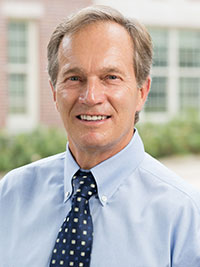Scott Powers
Distinguished Scholar in Health Sciences
My academic training and research background reside in exercise physiology/physiology with a focus on skeletal and cardiac muscle physiology/biochemistry. I am also an enthusiastic teacher and enjoy mentoring students interested in both research and health-related careers.
- PhD, Lousiana State University
- EdD, physiology, University of Tennessee
- MEd, exercise science, University of Georgia
- BS, physical education and health, Carson Newman University

Biography
Scott K. Powers, PhD, is currently a Distinguished Scholar in the Department of Health Sciences at Stetson University. Prior to joining the faculty at Stetson, Powers served as both the UAA Endowed Professor and a Distinguished professor within the Department of Applied Physiology at the University of Florida. Power's research has focused upon the effects of exercise and inactivity on the health of both cardiac and skeletal muscles. Collectively, his research has resulted in 260 peer-reviewed publications and many of these publications are widely cited in the literature.
Powers is also an author of a widely used textbook in exercise physiology. Professor Powers is also an accomplished teacher as indicated by the fact that he has won numerous teaching awards and has been inducted by the University of Florida as a member of the Academy of Distinguished Teaching Scholars. Moreover, he has also been recognized by the University of Florida as the Teacher/Scholar of the year in 2017.
More About Scott Powers
Areas of Expertise
- Physiology
- Cardiac and skeletal muscle wasting
- Exercise physiology
Course Sampling
- Exercise physiology
- Exercise is medicine
- Clinical exercise physiology
- Skeletal muscle wasting
- Exercise-induced preconditioning of skeletal muscles
- Exercise-induced cardioprotection
- Hyatt, H.W. and S.K. Powers, Mitochondrial Dysfunction Is a Common Denominator Linking Skeletal Muscle Wasting Due to Disease, Aging, and Prolonged Inactivity. Antioxidants (Basel), 2021. 10(4).
- Hyatt, H.W., et al., Calpains play an essential role in mechanical ventilation-induced diaphragmatic weakness and mitochondrial dysfunction. Redox Biol, 2021. 38: p. 101802.
- Powers, S.K., M. Ozdemir, and H. Hyatt, Redox Control of Proteolysis During Inactivity-Induced Skeletal Muscle Atrophy. Antioxid Redox Signal, 2020. 33(8): p. 559-569.
- Powers, S.K., et al., Exercise-induced oxidative stress: Friend or foe? J Sport Health Sci, 2020. 9(5): p. 415-425.
- Powers, S.K., et al., Mechanisms of exercise-induced preconditioning in skeletal muscles. Redox Biol, 2020. 35: p. 101462.
- Hyatt, H.W. and S.K. Powers, Disturbances in Calcium Homeostasis Promotes Skeletal Muscle Atrophy: Lessons From Ventilator-Induced Diaphragm Wasting. Front Physiol, 2020. 11: p. 615351.
- Hall, S.E., et al., Comparative Efficacy of Angiotensin II Type 1 Receptor Blockers Against Ventilator-Induced Diaphragm Dysfunction in Rats. Clin Transl Sci, 2020.
- Deminice, R., et al., Human and Rodent Skeletal Muscles Express Angiotensin II Type 1 Receptors. Cells, 2020. 9(7).
- Smuder, A.J., et al., Effects of exercise preconditioning and HSP72 on diaphragm muscle function during mechanical ventilation. J Cachexia Sarcopenia Muscle, 2019. 10(4): p. 767-781.
- Morton, A.B., et al., Increased SOD2 in the diaphragm contributes to exercise-induced protection against ventilator-induced diaphragm dysfunction. Redox Biol, 2019. 20: p. 402-413.